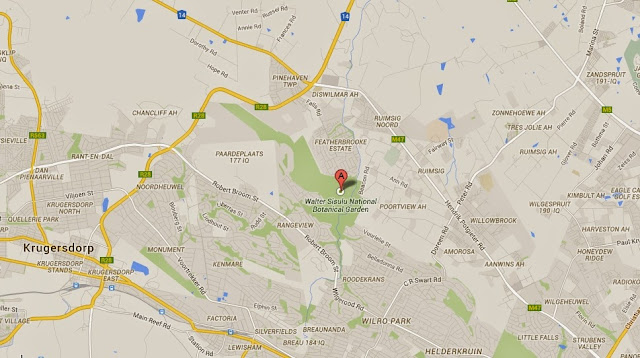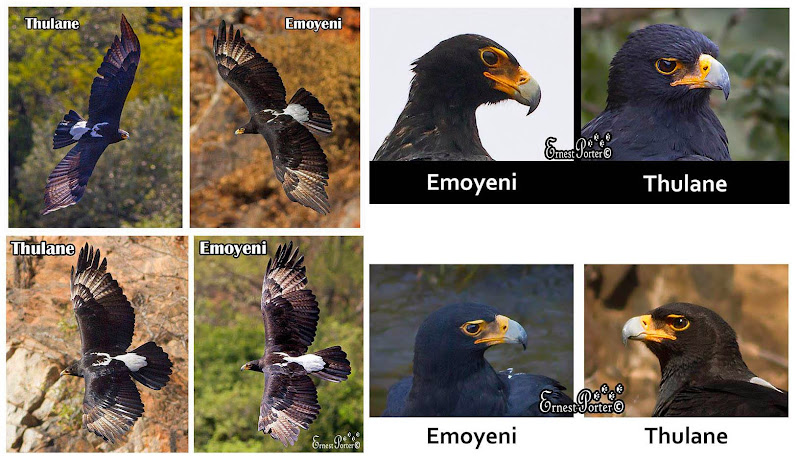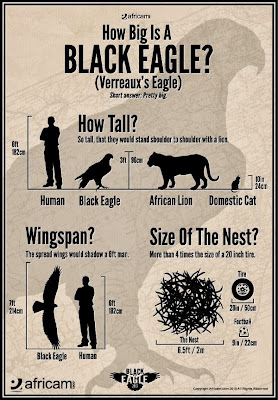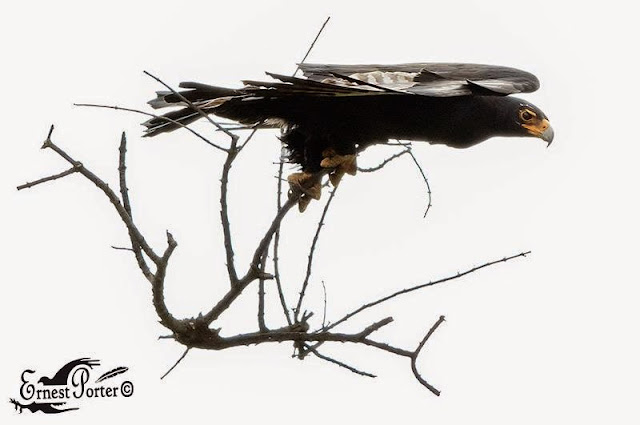The Black Eagle Project at Roodekrans
The nest of the Black Eagles is at the Walter Sisulu (Witwatersrand) National Botanical Garden near Johannesburg, South Africa. It is monitored by the Black Eagle Monitoring Project (BEMP), which aims at educating and informing the public about the Black Eagles and raptors in general, conserving and securing the Black Eagles in the Walter Sisulu (Witwatersrand) National Botanical Garden for future generations to enjoy and monitoring and obtaining vital information on their breeding cycle. In 1998, Black Eagle Monitoring Project (BEMP) broke away from Raptor Conservation Group and became affiliated to the Walter Sisulu (Witwatersrand) National Botanical Garden. The project was renamed the Black Eagle Project Roodekrans (BEPR) and was registered as a Section 21, non- profit organisation, with its own constitution, bank accounts and appointed auditor. The project consists of a 7-member committee and approximately 30 dedicated volunteer members.
 Map by Google Maps
Map by Google Maps
The nest is situated near the Witpoortjie Falls and is probably used already for many generations of Black Eagles.
The present pair nesting there:
EMOYENI
“UPON THE WIND”
The grand old lady is probably over 40years old and is loved by many who have followed her life cycles with passionate interest. The first sightings of Emoyeni were in the early 1970′s with her first mate; unfortunately we do not know anything about him. Quatele was her second mate and she scoured the ridges searching for him when he disappeared in 1998. Emoyeni patiently taught her third mate Thulane everything she knew, tolerating his initial shortcomings, but now appreciating his newfound expertise. Many a lesson could be learnt from this magnificent black eagle.

This magnificent photo of Emoyeni was taken by Ernest Porter and is his copyright
Emoyeni's mate for life is now:
THULANE
“THE SHY ONE “
The joyful outcome of 1998 was the arrival of the new male, just sexually mature, shy and inexperienced. Barely in his first year of adulthood, as he was small in length and wingspan, the “V” on his back was not quite developed and his inside leggings were still pale. He still had so much to learn, his insecurities with mating and nest building showed, but there again he had a patient teacher – Emoyeni. However, “the shy one” has proved to be a good pupil and has matured into a mighty species.

Thulane, copyright Ernest Porter
As it is difficult to see a difference, there was a nice set of photos showing the two eagles in comparison:

Again - copyright is with Ernest Porter
A short history about the nest:
The Roodekrans pair have bred successfully since 1993 with exception of 1996, 2000 and 2002. In 1994 the eagles made the history books by laying twice in one season, unfortunately the first juvenile was chased from the territory before it had learnt how to survive in the wild and was killed by a caracal. The next year they laid a three-egg clutch, this is unheard of for black eagles. In 1998 when the previous male disappeared the female abandoned her incubation and went in search of her mate, to no avail, but went on to raise a juvenile later in the year with the arrival of a new male.
An interesting table I found about the chicks hatched, ringed and fledged:
2006 - 2010
 2006
2006
The eggs were laid 11th / 16th April respectively with only the second egg hatching on the 31st May 2006. The first chick died of exhaustion during hatching, as it was probably not strong enough to break out of it. This year the project placed a ring on the right tarsus of the eaglet before fledging, a minuscule drop of blood was taken to confirm the sex of the bird. The juvenile fledged the nest at 99 days on the 7th September 2006. Blood tests confirmed that the juvenile was a male and he left the territory around the 17th December 2006. There have been sightings of the youngster in the Aloe Ridge area.
2007
The clutch was laid on the 11th / 16th April respectively. Only the first hatched on the 26th May, although the second egg was holed the chick did not hatch. Fledging took place on the 2nd September at 98 days. The juvenile had a ring placed on its left tarsus and blood tests reveal that it was a female. On the 15th December the eaglet vacated the breeding territory.
2008
This year the female laid two eggs 4 days apart on the 11th April 2008 and 15th April 2008. Both eggs hatched on the 24th May 2008 and 27th May 2008, respectively. After 3 years of only having one egg hatch it was great that this year both hatched. Cain and Abel lasted for 4 days when the younger of the two eventually died. Fledging took place on the 2nd September 2008, with the male dive bombing the juvenile on the nest – this was because of a lack of prey in the area. Unfortunately, the male would not allow the juvenile to stay in the territory and would attack it cruelly when the female would offer it prey. This strange behaviour chased the juvenile out of the immediate natal bowl which in turn denied the young juvenile the opportunity to learn its survival skills from the adults. The last sighting of the juvenile was mid October 2008. Unfortunately, its survival rate will be minimal and will probably have been preyed upon by a black backed jackal or caracal.
2009
The eggs were laid on the 15th and 19th April respectively, there was no Cain and Abel this year as Abel was very week on hatching and died the same day. Cain grew quickly and finally left the nest early in September. The adults were able to supply enough prey for the growing juvenile and it grew into a magnificent young eagle finally leaving the nest in November.
2010
The year of Bafana. A successful year with two eggs being laid on the 9th and 12th April respectively. Only one egg hatched on the 24th May. This year the researcher decided to attach a tag to the juveniles wing as well as a ring to the tarsus, unfortunately the female in trying to remove this tag broke the juveniles leg and it had to be removed from the nest. The juvenile’s leg was pinned and it made a wonderful recovery. It was rehabilitated and released back into the wild.
2011
Successful breeding season from which Mbuso was raised. Two eggs were laid on the 17th and 22nd April respectively, with the first egg hatching on the 31st May and the second on the 4th June. Unfortunately the young chick only survived a matter of hours. Cain went on to become a healthy juvenile and fledged from the nest in September, we suspect it was a male. He eventually left the territory around mid December.
2012
Successful breeding season from which Jabulani was raised. Eggs laid 22nd /26th April respectively. Hatched, 5th/9th June respectively. Eaglet fledged 13th September and left territory mid December. Bottom nest.
2013/14
During the first season we were watching this cam, they had one chick which was called Nessi:
Nessi (“miracle”), from a second clutch laid late in the breeding season after the failure of the first, had to face the hot and rainy African summer on the cliff face nest. With the odds stacked against Nessi, he has grown up to be a strong, healthy and handsome immature eagle.
Egg was laid on 14th August 2013 / Hatched on 28th September 2013
Fledged on 31st December 2013 / Left its natal home range, mid-March 2014

Copyright by Ernest Porter
2014
First egg was laid on 30th April, second on 4th May. First egg hatched on 13th June, second on 17th.
The surviving eaglet was called Jono after the Jon Oliver, CEO of Africam.com who had passed away just shortly before.
Jono fledged on September 10th and left the area on December 12th.

Copyright by Ernest Porter
(Some more information about previous chicks can be found here:
http://www.blackeagles.co.za/?page_id=93 )
The young eagles are not ringed (banded) anymore due to the fact that Emoyeni once broke the leg of the eaglet trying to remove a tag. (see 2010, Bafana). Like this it is unfortunately not possible to get follow-ups of the juveniles leaving the parental territory.
The information was taken from:
http://www.blackeagles.co.za/ and the Facebook page:
http://www.blackeagles.co.za/
and remain their copyright.
























